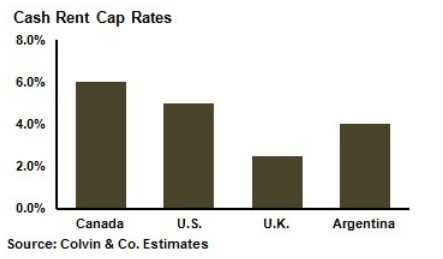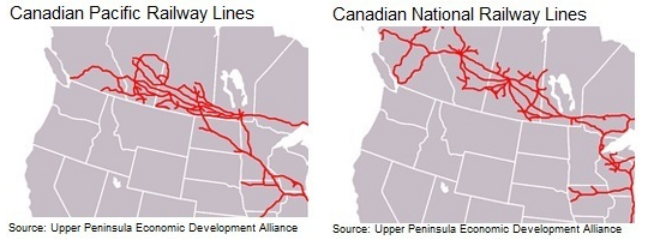Investing in agriculture has been one of the most popular investments over the last two years due to multi-decade low global grain supplies and growing demand from emerging markets. Grain prices and farmland values have risen substantially as capital has been attracted to agriculture’s rapid growth. The demand for agricultural assets has made attractive investment opportunities in agriculture harder and harder to find.
We recommend investors start looking farther north for compelling investment opportunities. Canada, the world’s seventh largest grain producer, is home to some of the world’s best farmland and agribusinesses. Despite Canada’s strong agricultural qualities, farmland valuations lag substantially behind the rest of the world.
For investor’s looking for investment opportunities in farmland, we see Canada as a compelling investment opportunity due to its attractive valuation, potential for substantial increases in production, and improving profitability. Investing in Canadian farmland today could turn out to be equivalent to investing in Midwestern U.S. farmland in 2009.
Attractive Valuations
Capitalization rates (rental income/price) in Canada are very attractive compared to the U.S. and the rest of the world. With proper sourcing and due diligence, farmland in Canada can be obtained at 6-7% cap rates. This compares to farmland cap rates of 5-5.5% in the U.S. Corn Belt, 4% in Argentina, and only 2-2.5% in the U.K. There are many reasons for the difference in cap rates across countries, but we believe the primary factor for the above average cap rates in Canada is the lag in appreciation compared to the rest of the world.
Canadian farmland values have performed well over the past 12 months, but not as fast as the U.S. Corn Belt. Saskatchewan farmland values increased by 14.3% year over year, according to Farm Credit Canada, while prime U.S. farmland increased by 31% in Iowa, according to The Federal Reserve Bank of Chicago. Alberta farmland increased in value by 5.5% year over year and Manitoba by 3.7%.
Dissolution of Canadian Wheat Board
For 76 years, the government operated Canadian Wheat Board (CWB) has maintained a monopoly on purchasing and selling wheat and barley in Manitoba, Saskatchewan, Alberta, and parts of British Columbia. The grain market monopoly will come to an end in August of 2012 as Canada's Conservative Party passed a bill in 2011 to strip the board of its control.
Many farmers, investors, and businesses alike are excited to participate in a free market and benefit from market prices. Businesses will have more reason to build facilities and infrastructure if they can buy grain directly from farmers, rather than paying a premium through the CWB. Farmers will have the ability to turn a larger profit margin as they will be able to better time the market and sell grain at more opportunistic points throughout the year.
Higher revenues for farmers will directly affect the underlying farmland values. Farmers will be incentivized to increase production through planting more acres and investing in innovation to increase efficiency. Increased profitability, infrastructure, and efficiency are all tremendous ingredients to attract investors. Canadian grain will finally be free at last.
Rising Production
Weather in the southern plains of Canada is very similar to the U.S. Corn Belt with two major exceptions. The first difference is the length of the growing season. On average, the growing season is 52 days shorter, which requires shorter maturity seeds that result in substantially lower yields than the Corn Belt. The second difference is the amount of precipitation. Cedar Rapids, Iowa receives an average of 34.7 inches of precipitation per year, according to The Weather Channel, while Regina, Saskatchewan receives under half as much precipitation at 14.3 inches annually.
Canadian farmland does feature an extremely cold winter frost that will naturally deter insects, plant disease, and soil compaction. Even less pesticide is needed in Canada than in the U.S. which should help farmer input costs remain relatively lower.
Global demand for corn is rising substantially each year. As a result, more acres are being allocated to corn production in the Midwest and soon the trend of planting corn will be spreading into Canada. Cold tolerance is an issue in Canada as the growing season is shorter than that of the Corn Belt. Seed companies invest millions of dollars each year into research and development for new and improved cold and drought tolerant hybrids. Due to advances in biotechnology, scientists have been able to produce cold tolerant hybrid seeds that are able to be planted earlier in the spring season. These cold tolerant seeds have allowed corn to be planted in regions of Canada where we never thought possible and the area will continue to spread.
Seed varieties are expanding into shorter maturity dates as well. 120 day corn grows well in central Illinois, but much shorter maturity is needed moving north as the growing season shortens. Companies such as Monsanto, DuPont, and Croplan Genetics continually shorten the maturity dates of field corn allowing for such expansion of the traditional Corn Belt.
Strategic Location
Emerging markets of China and India will continue to demand an ever increasing amount of corn and soybeans, which will need to be shipped through the Pacific Northwest ports of North America. Canadian farmland poses an excellent competitive advantage over U.S. farmland as Canadian farmland is located substantially closer to the ports in the Pacific Northwest.
Rail lines, including Canadian National and Canadian Pacific, will help transport valuable grain grown in the southern plains of Canada to the western seaboard for export to China and other emerging markets in Asia.
Due to the expanding grain logistics along the current rail lines in British Columbia, Alberta, Saskatchewan, and Manitoba, grain offtakes such as elevators and ethanol plants will compete for grain and drive the local commodity prices higher, translating to higher farm income and farmland values over time.
Excellent Soil Quality
The southern plains of Canada are comprised of the same top quality Mollisol soil types as the Midwestern U.S. Mollisol soils are only found in four areas in the world; central North America, the Pampas region of Argentina, the Steepes of Ukraine, and the Yellow River Valley of China. These soils are thick, contain excellent top soil, and have large amounts of organic material which efficiently hold moisture and fertilizers. These characteristics make Mollisols ideal for producing row crops like corn and soybeans.
There is variance across Mollisols, but strong yielding corn and soybean crops will grow on all Mollisol soils leaving climate as the limiting factor in Canada. High quality soil in the southern plains of Canada is very similar to 200+ bushel an acre corn soil in Iowa and Illinois, yet currently valued at a 75% discount.
Crop Diversification
The variety of crops grown in the southern provinces of Canada provides diversification for farmers as upwards of 14 major crops are grown annually. Chiefly canola, wheat, oats, and rye are grown on the ancient tall grass prairies of Canada stretching from Alberta to Manitoba.
These key crops are in high demand for the manufacturing of food products for animal and human consumption worldwide and domestically. Saskatchewan, in particular, produces the most of these crops, as 44% of Canada's total cultivated farmland is located inside the province. In addition to crops being used for food, there is an increasing demand for Canadian grains to be used in biofuel production.
The U.S. has a goal to produce 36 billion gallons of renewable energy by the year 2022. In 2011, the U.S. produced 13.5 billion gallons of ethanol. In order to meet their goal, the U.S. is going to have to look elsewhere, and Canada is a prime candidate neighboring to the north. In September of 2011, the Environmental Protection Agency approved the use of Canadian crops in U.S. biofuels. Canada became the first country, outside the U.S., to gain such approval. The biofuel approval will generate a new demand for Canadian grains primarily driven by the U.S., to serve as a safe and local back-up.
Conclusion
We believe that growing demand for agriculture is going to create a substantial amount of wealth across the globe. The popularity of agriculture over the last two years has made it more difficult to identify attractive investment opportunities and we believe investors need to be selective.
We see Canadian farmland as the next frontier for investors as valuations on a relative basis to the U.S. and the rest of the world are very attractive. Improving technologies driving the expansion of the Corn Belt and better pricing due to the dissolution of the CWB, will continue to drive farmland values higher in Canada.
- English (UK)
- English (India)
- English (Canada)
- English (Australia)
- English (South Africa)
- English (Philippines)
- English (Nigeria)
- Deutsch
- Español (España)
- Español (México)
- Français
- Italiano
- Nederlands
- Português (Portugal)
- Polski
- Português (Brasil)
- Русский
- Türkçe
- العربية
- Ελληνικά
- Svenska
- Suomi
- עברית
- 日本語
- 한국어
- 简体中文
- 繁體中文
- Bahasa Indonesia
- Bahasa Melayu
- ไทย
- Tiếng Việt
- हिंदी
Attractive Investment Outlook for Canadian Farmland
Published 03/20/2012, 07:47 AM
Updated 07/09/2023, 06:31 AM
Attractive Investment Outlook for Canadian Farmland
3rd party Ad. Not an offer or recommendation by Investing.com. See disclosure here or
remove ads
.
Latest comments
Install Our App
Risk Disclosure: Trading in financial instruments and/or cryptocurrencies involves high risks including the risk of losing some, or all, of your investment amount, and may not be suitable for all investors. Prices of cryptocurrencies are extremely volatile and may be affected by external factors such as financial, regulatory or political events. Trading on margin increases the financial risks.
Before deciding to trade in financial instrument or cryptocurrencies you should be fully informed of the risks and costs associated with trading the financial markets, carefully consider your investment objectives, level of experience, and risk appetite, and seek professional advice where needed.
Fusion Media would like to remind you that the data contained in this website is not necessarily real-time nor accurate. The data and prices on the website are not necessarily provided by any market or exchange, but may be provided by market makers, and so prices may not be accurate and may differ from the actual price at any given market, meaning prices are indicative and not appropriate for trading purposes. Fusion Media and any provider of the data contained in this website will not accept liability for any loss or damage as a result of your trading, or your reliance on the information contained within this website.
It is prohibited to use, store, reproduce, display, modify, transmit or distribute the data contained in this website without the explicit prior written permission of Fusion Media and/or the data provider. All intellectual property rights are reserved by the providers and/or the exchange providing the data contained in this website.
Fusion Media may be compensated by the advertisers that appear on the website, based on your interaction with the advertisements or advertisers.
Before deciding to trade in financial instrument or cryptocurrencies you should be fully informed of the risks and costs associated with trading the financial markets, carefully consider your investment objectives, level of experience, and risk appetite, and seek professional advice where needed.
Fusion Media would like to remind you that the data contained in this website is not necessarily real-time nor accurate. The data and prices on the website are not necessarily provided by any market or exchange, but may be provided by market makers, and so prices may not be accurate and may differ from the actual price at any given market, meaning prices are indicative and not appropriate for trading purposes. Fusion Media and any provider of the data contained in this website will not accept liability for any loss or damage as a result of your trading, or your reliance on the information contained within this website.
It is prohibited to use, store, reproduce, display, modify, transmit or distribute the data contained in this website without the explicit prior written permission of Fusion Media and/or the data provider. All intellectual property rights are reserved by the providers and/or the exchange providing the data contained in this website.
Fusion Media may be compensated by the advertisers that appear on the website, based on your interaction with the advertisements or advertisers.
© 2007-2024 - Fusion Media Limited. All Rights Reserved.
